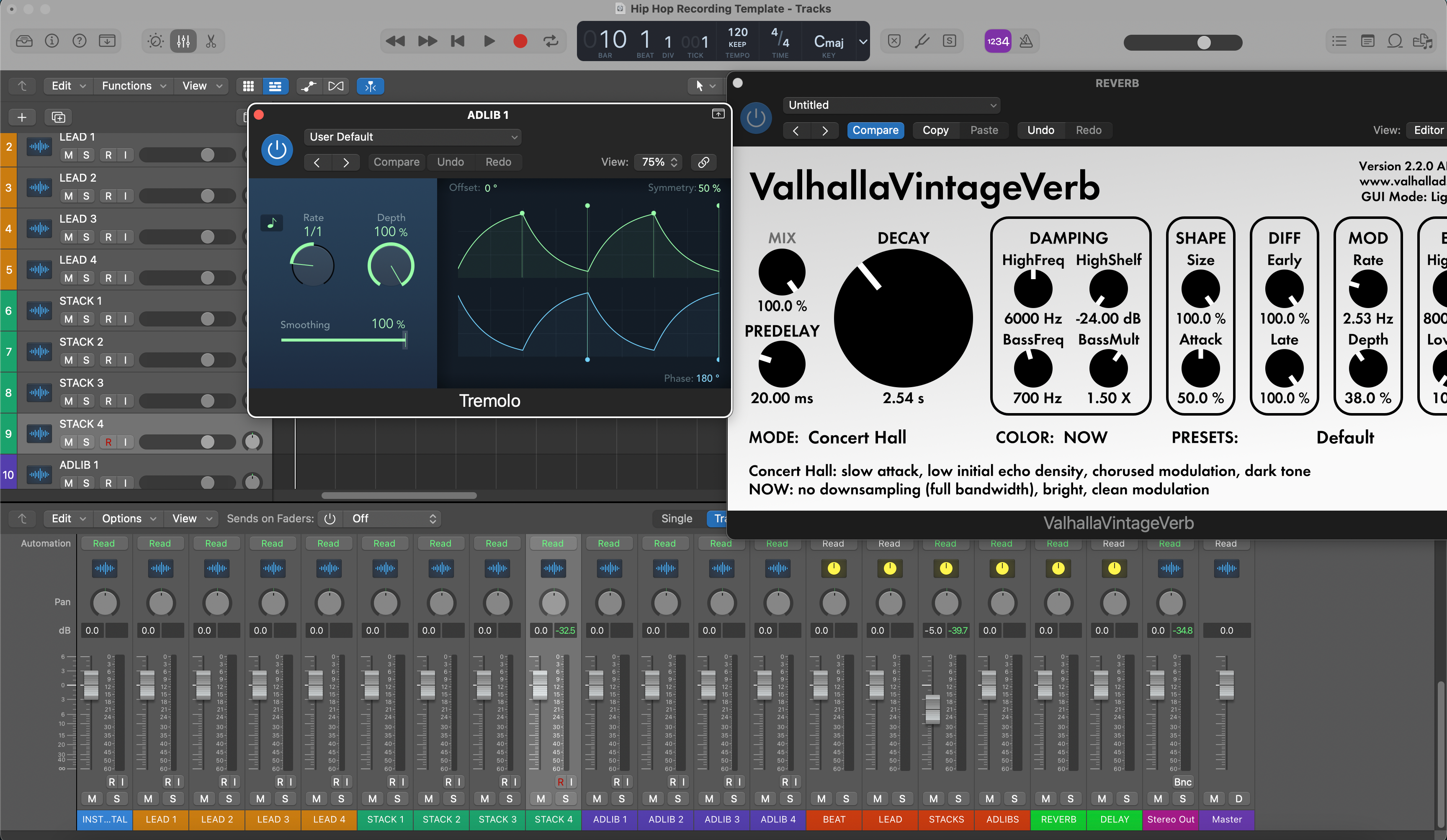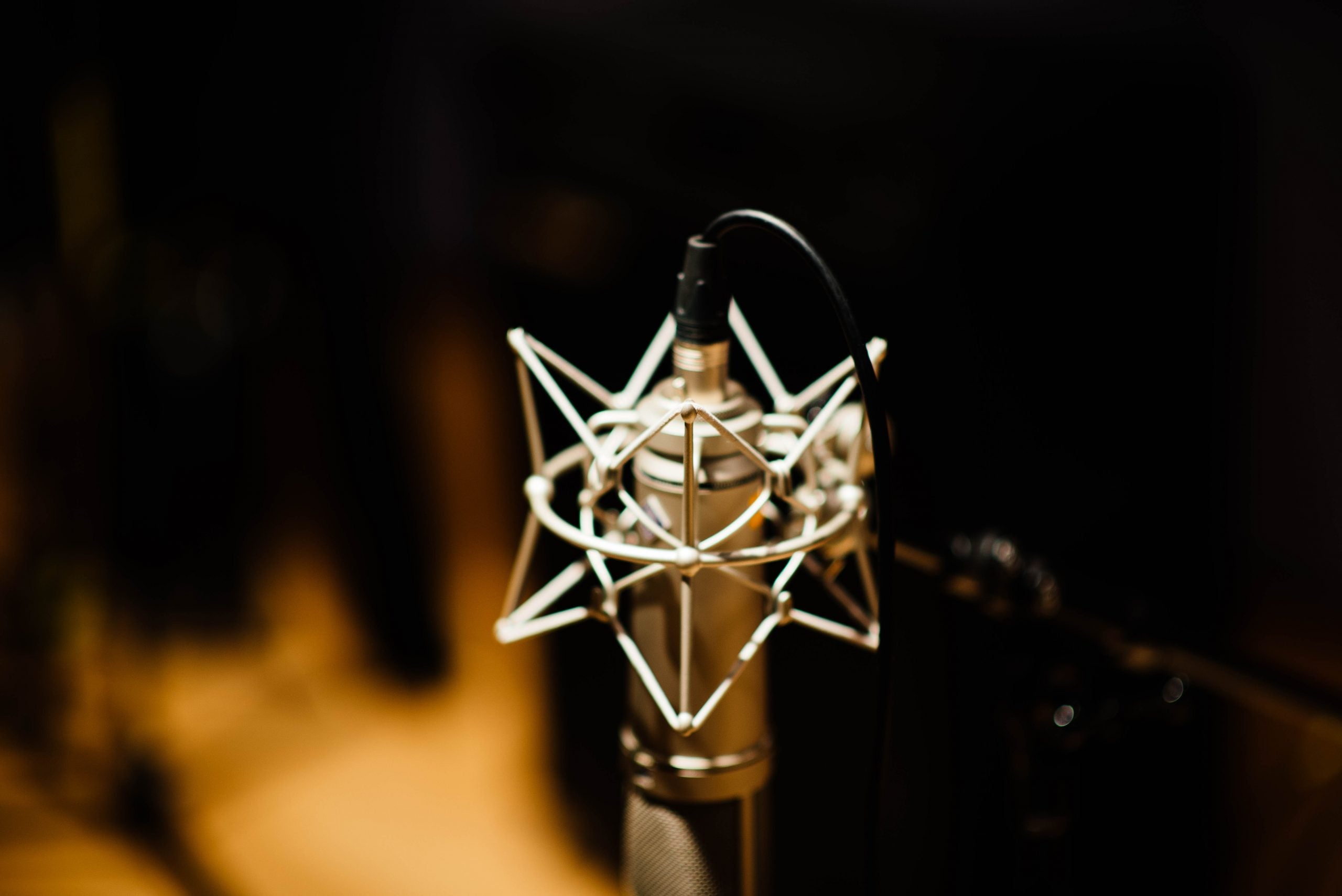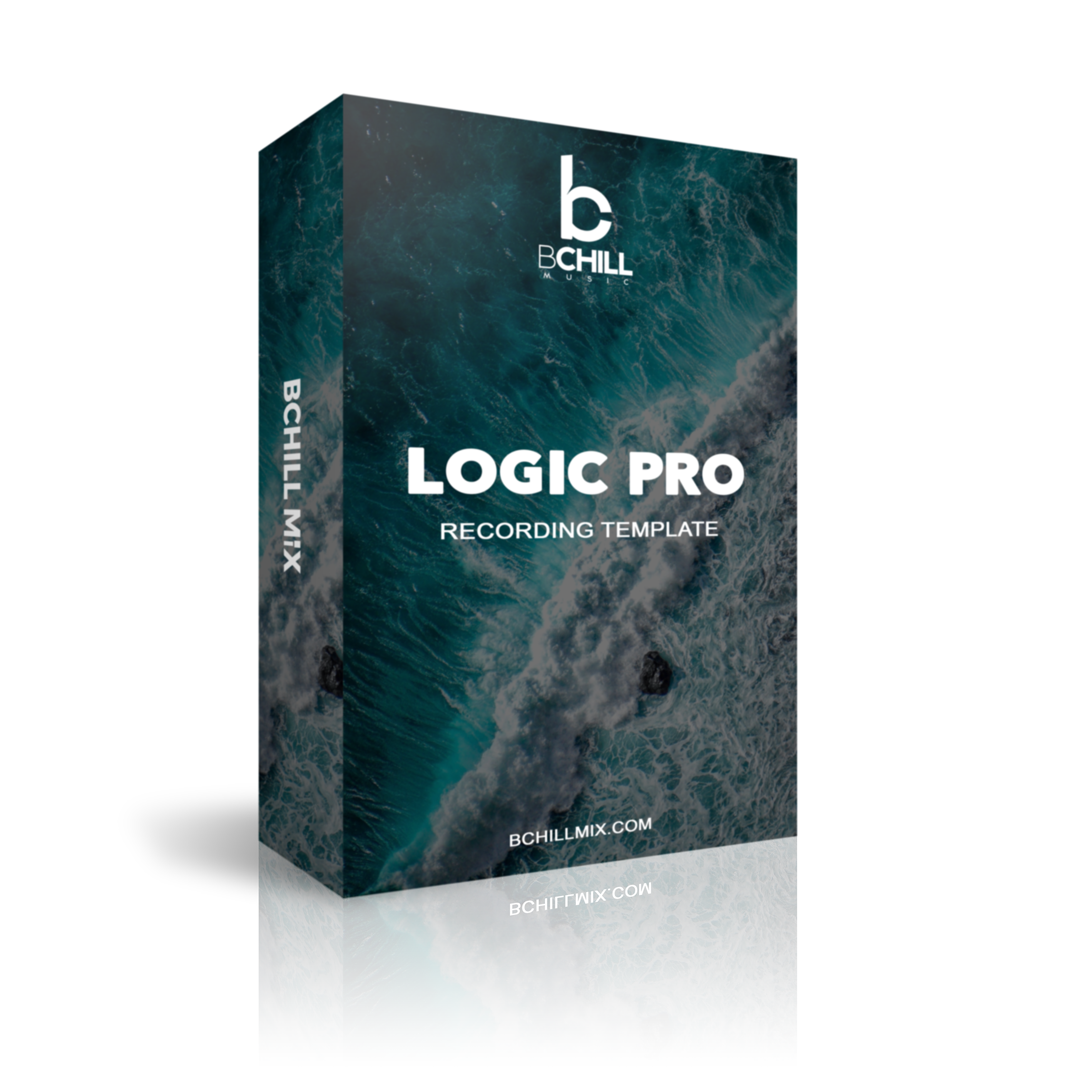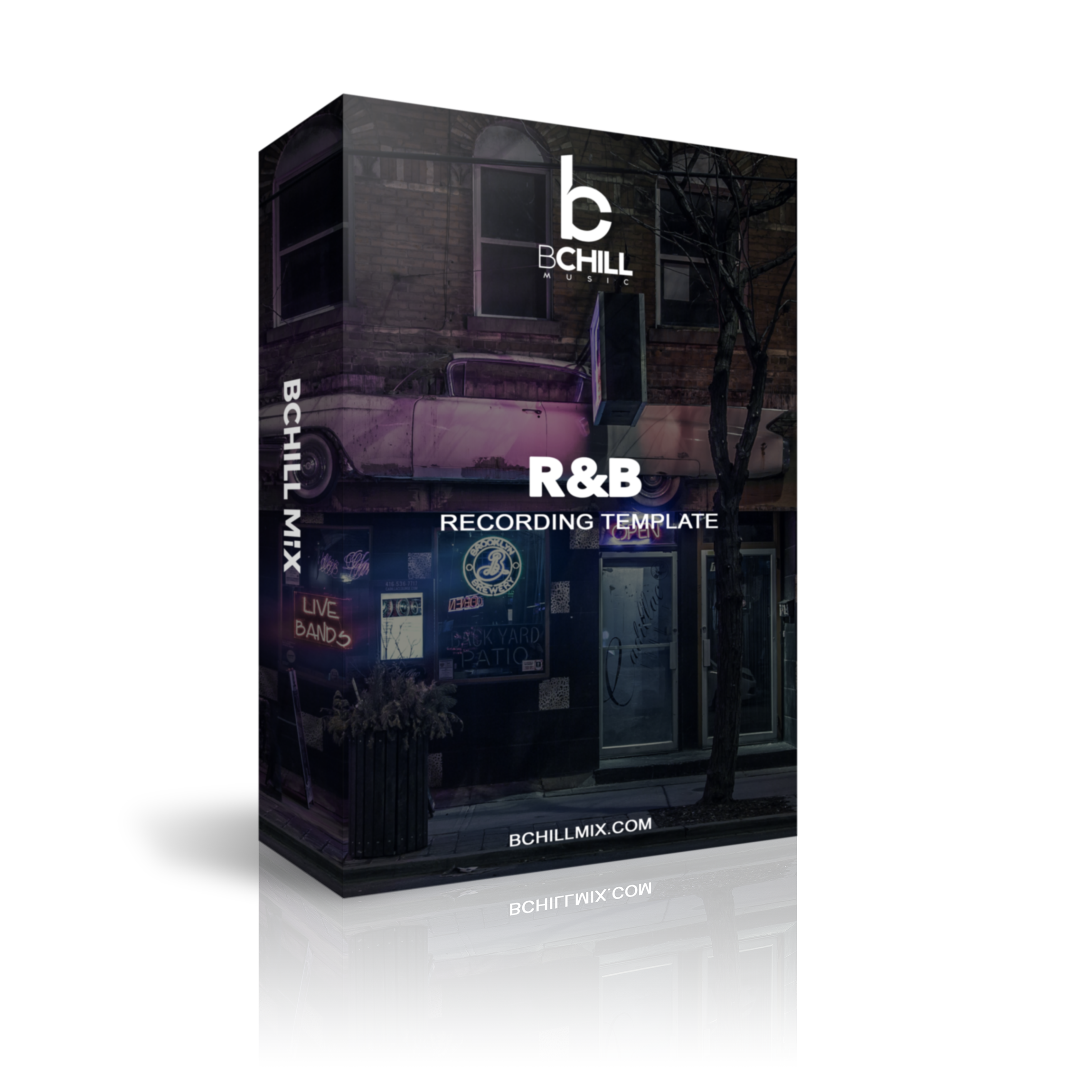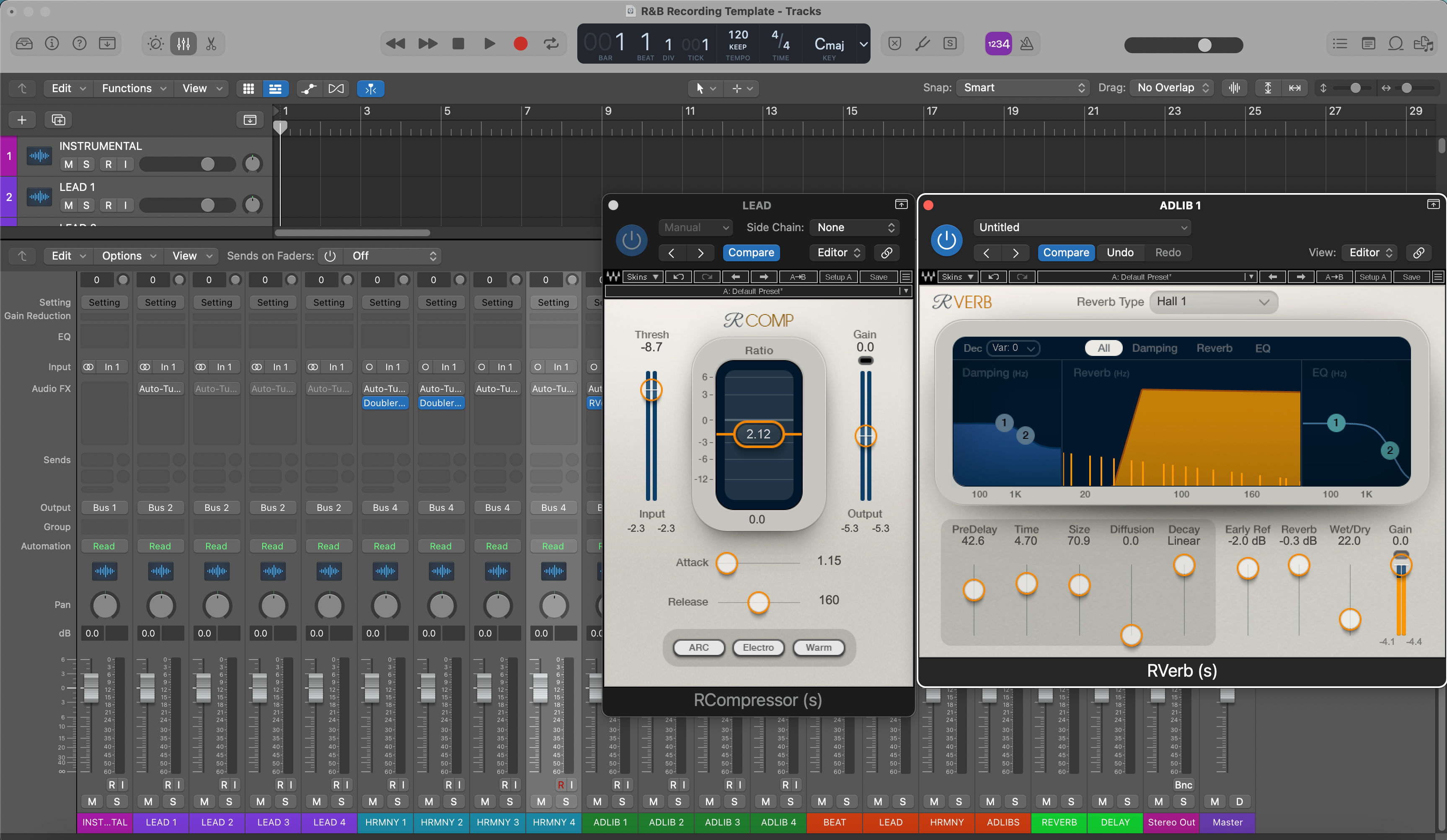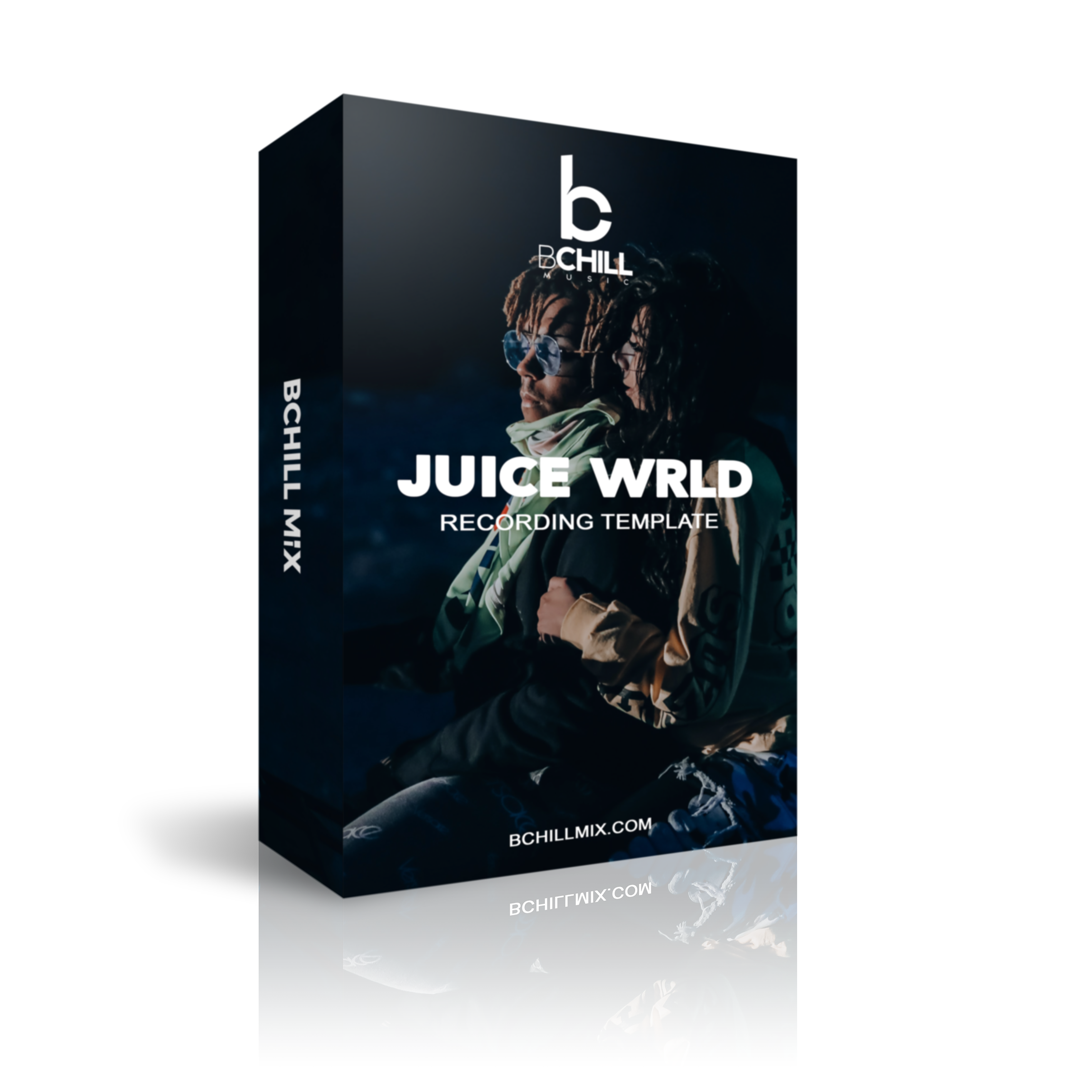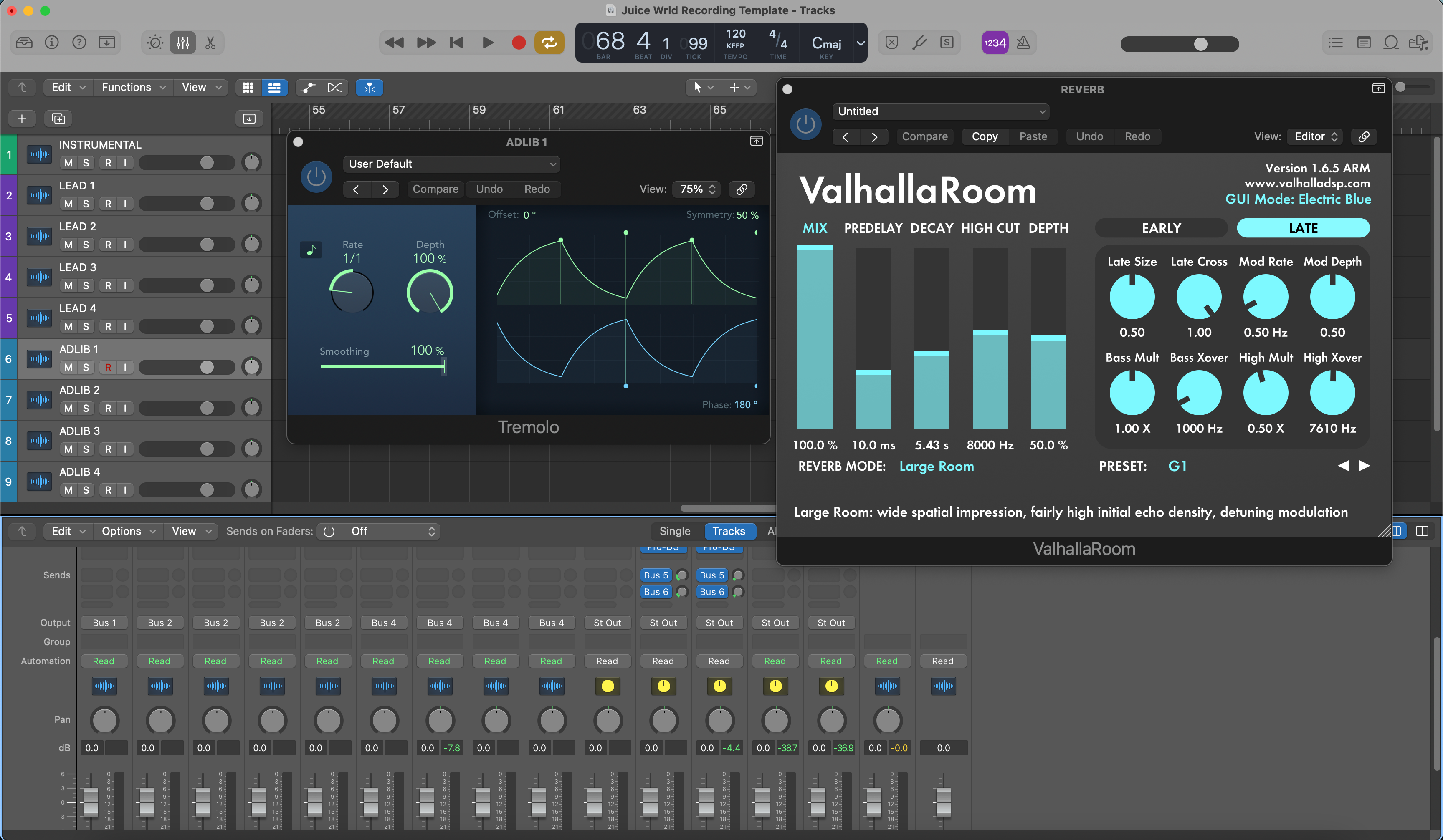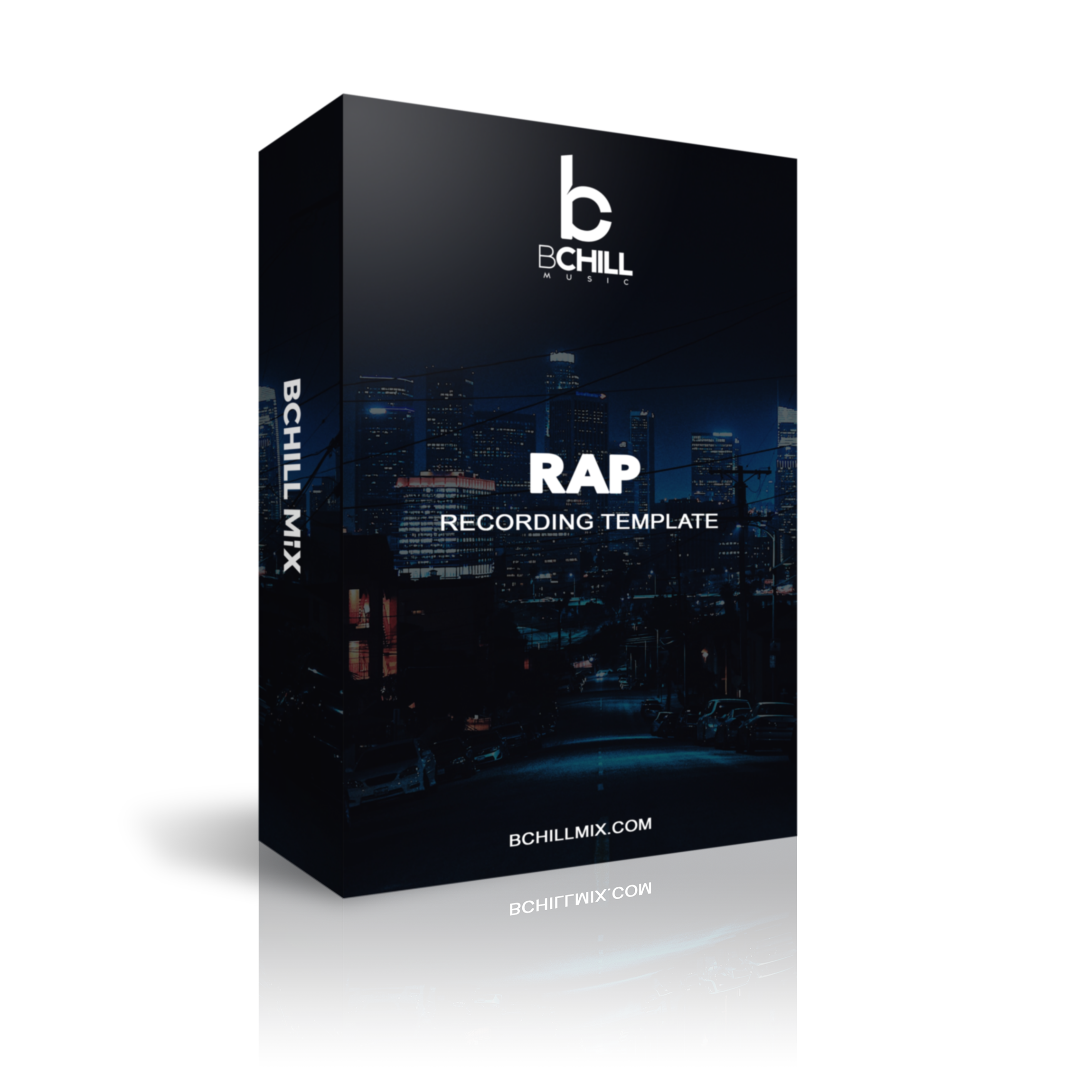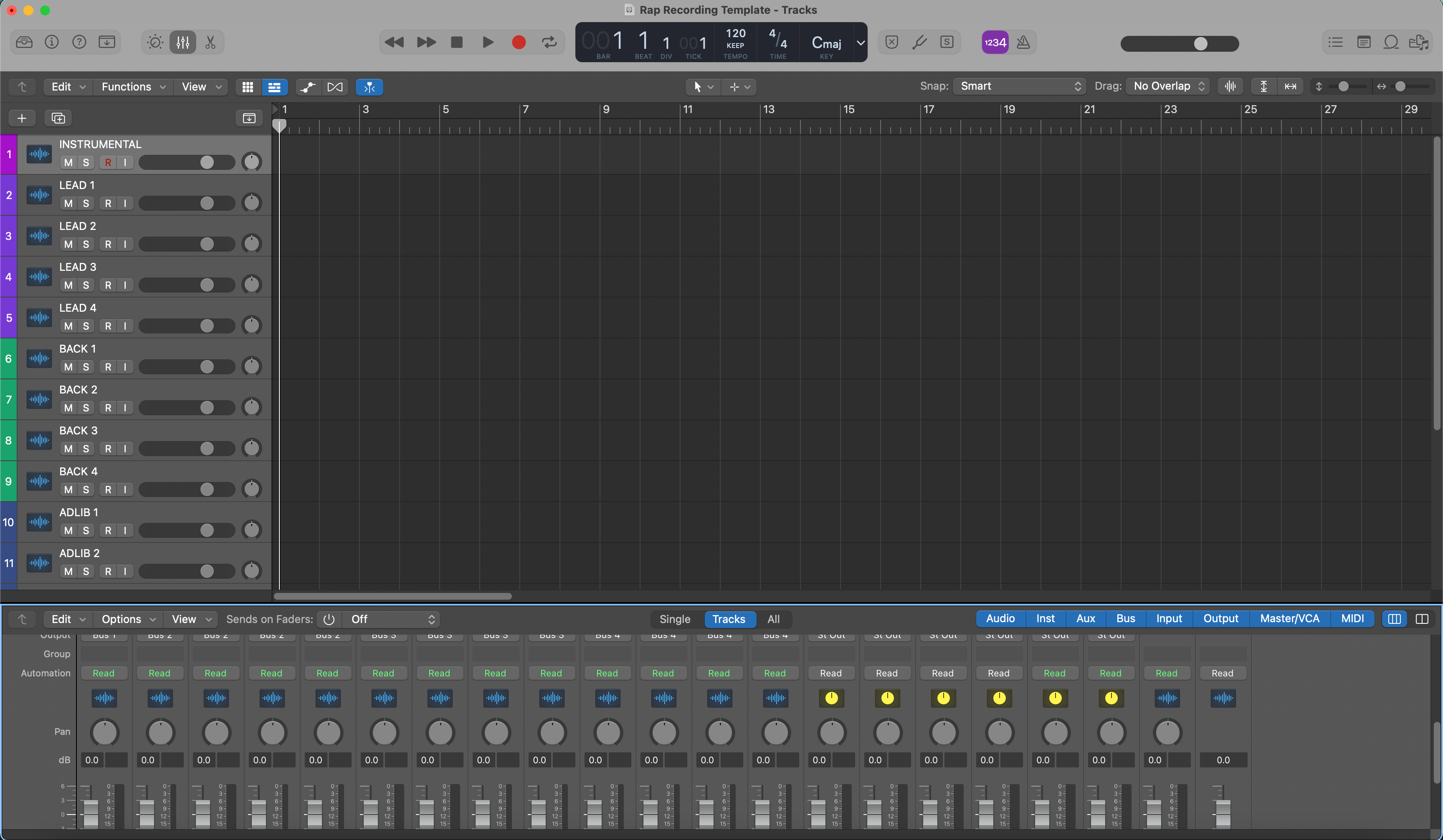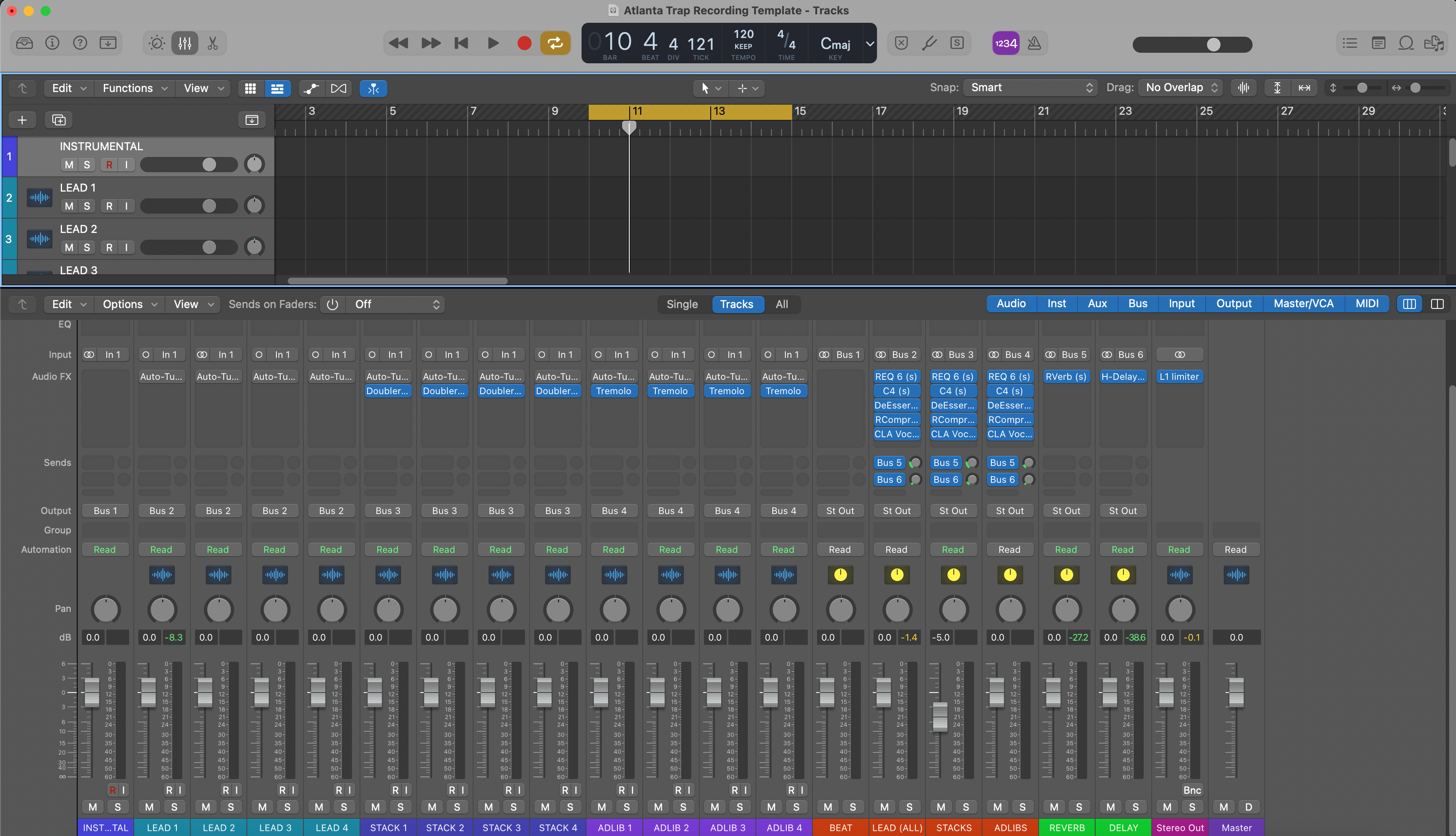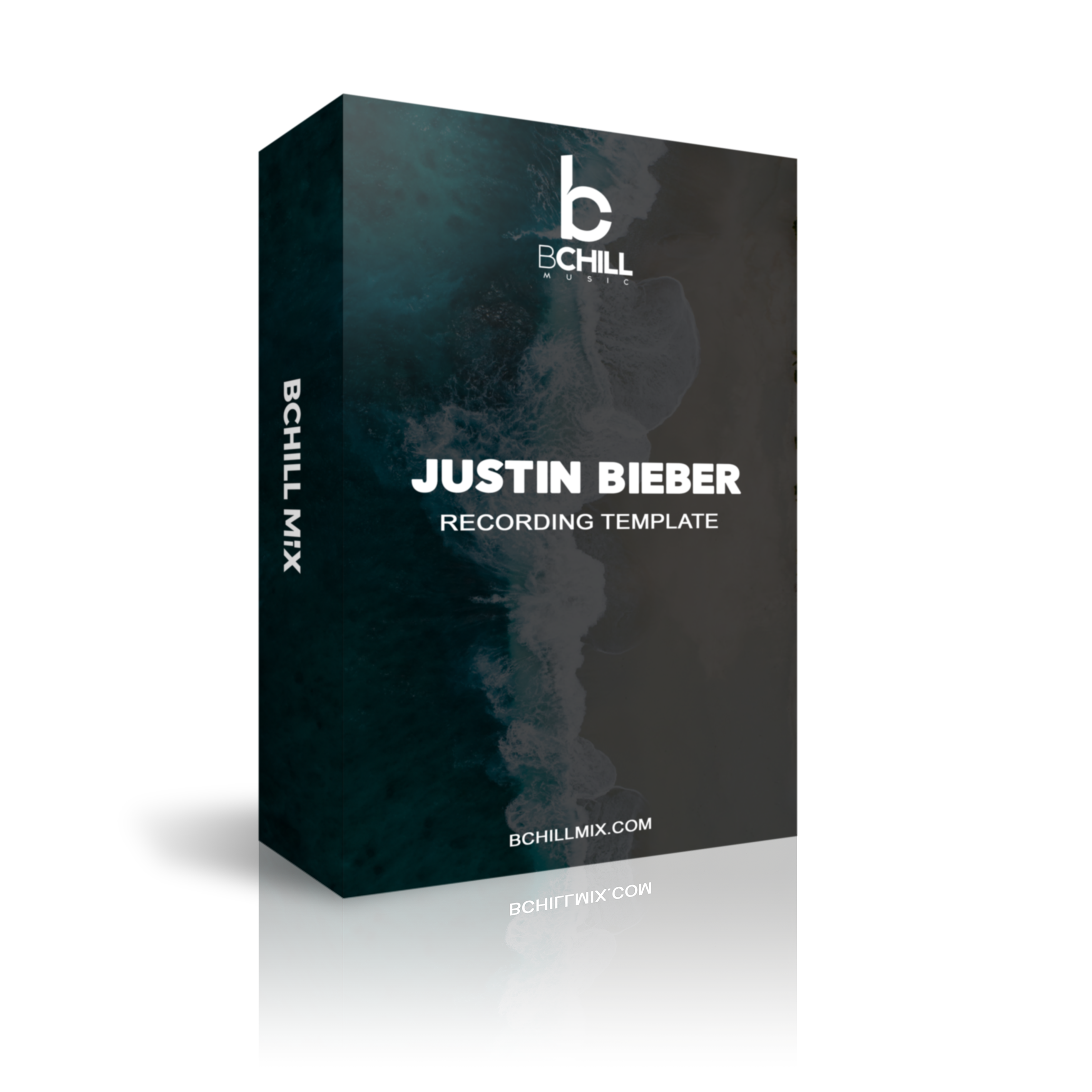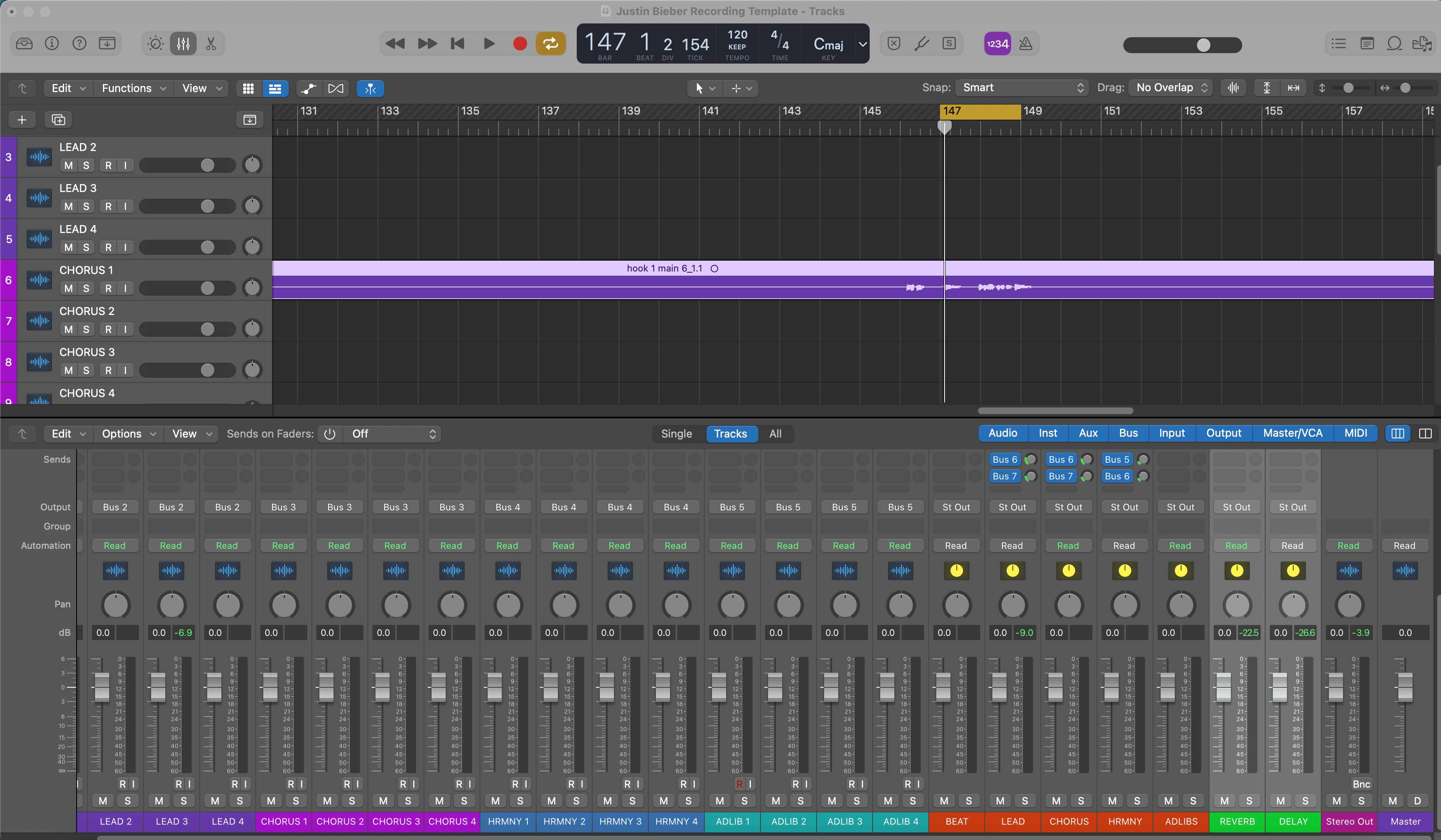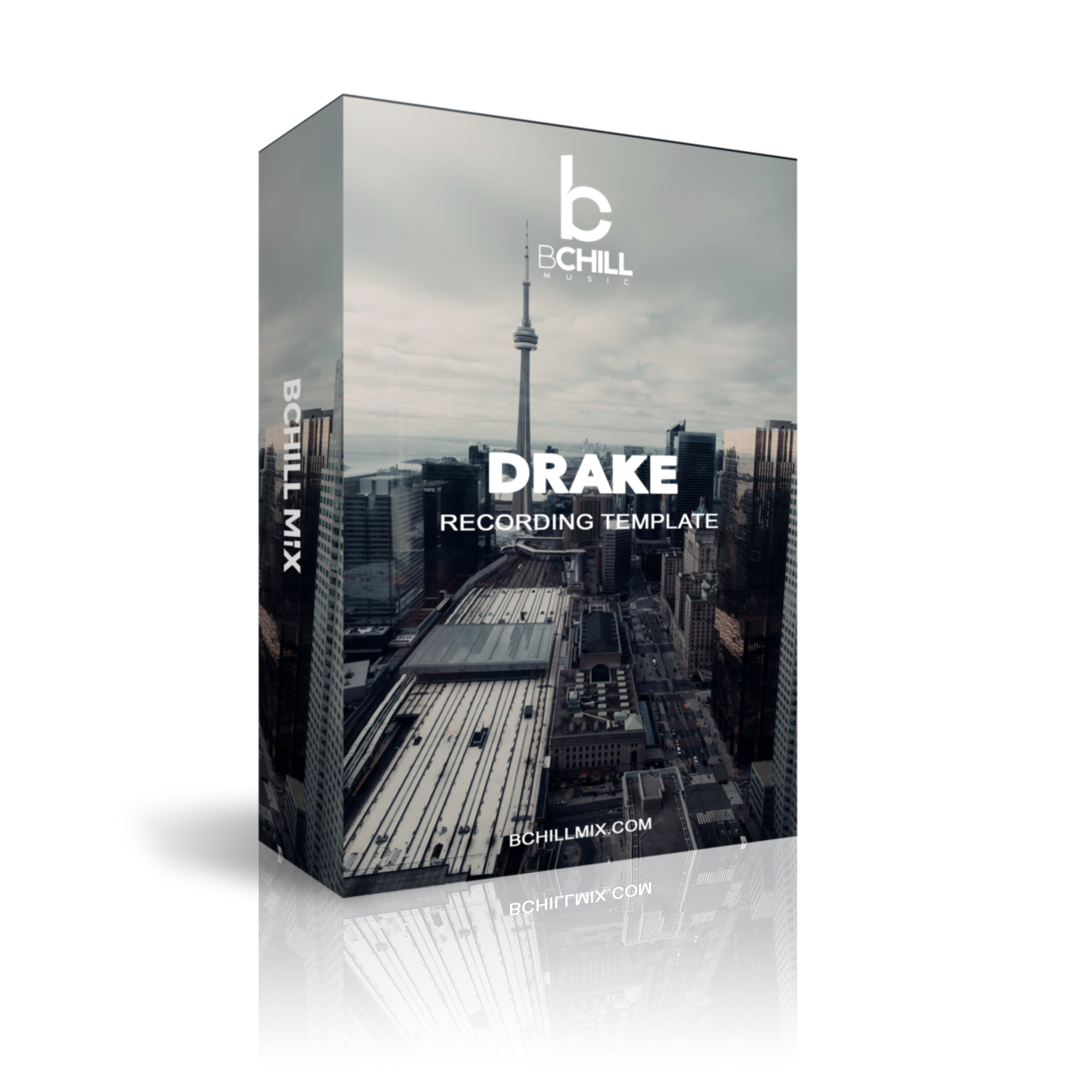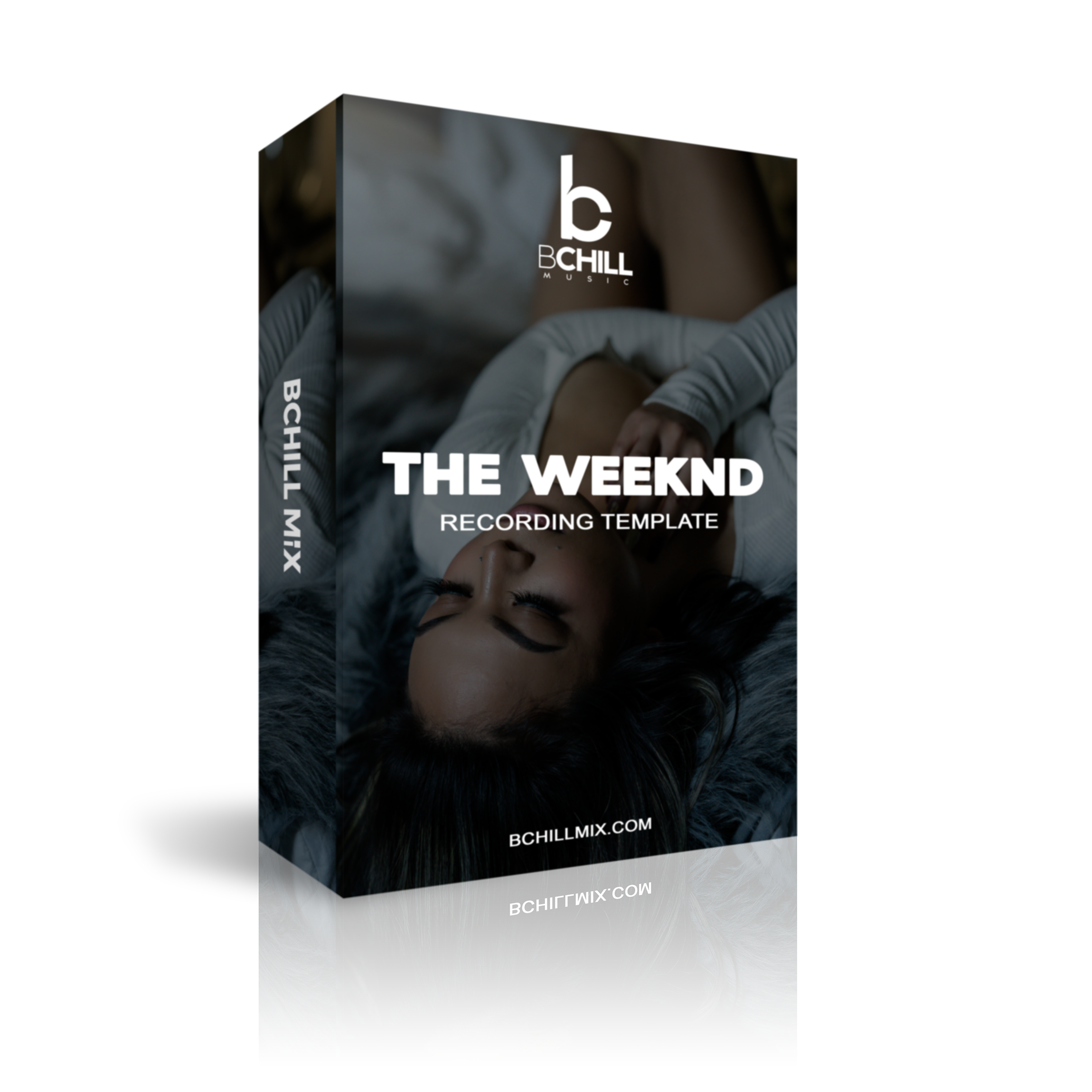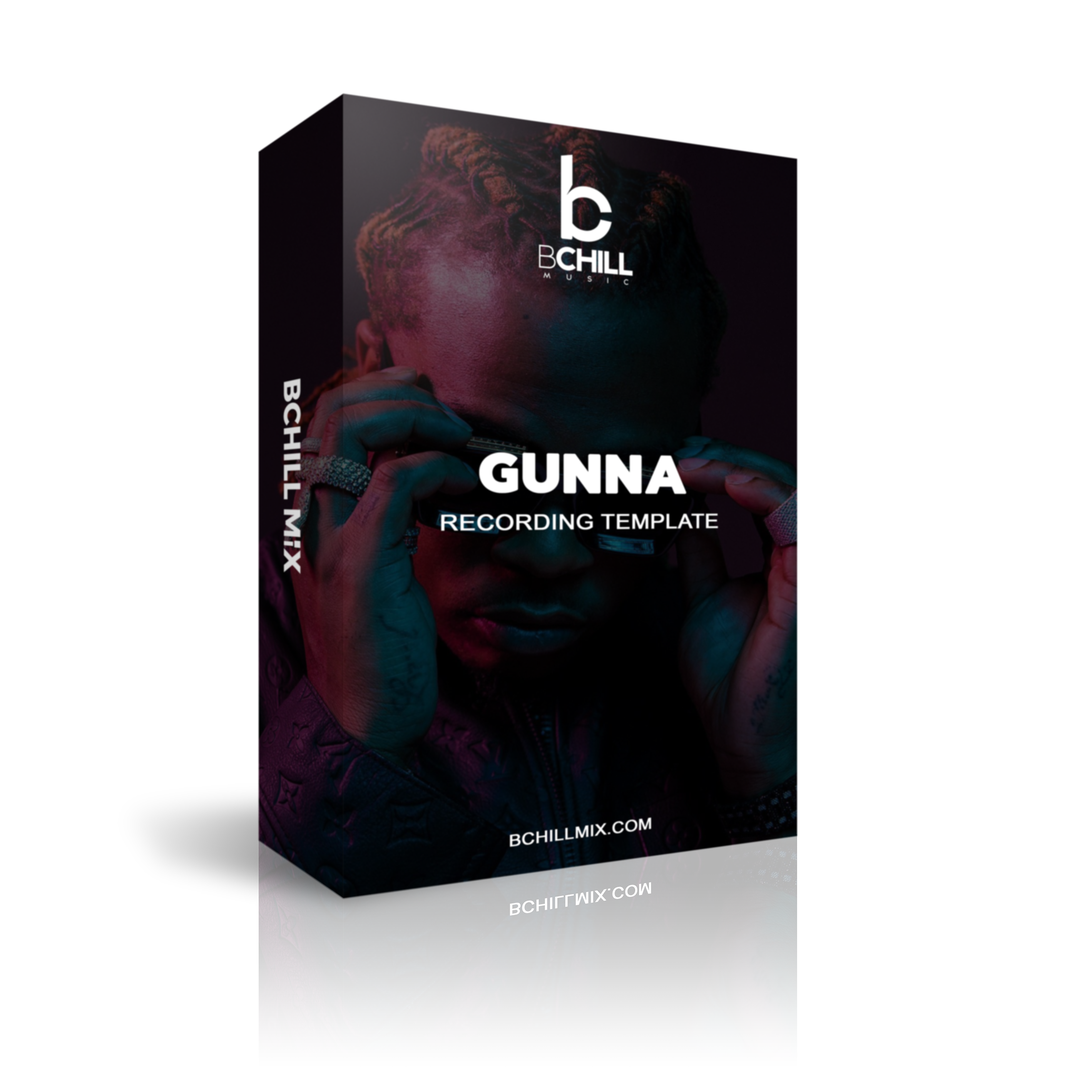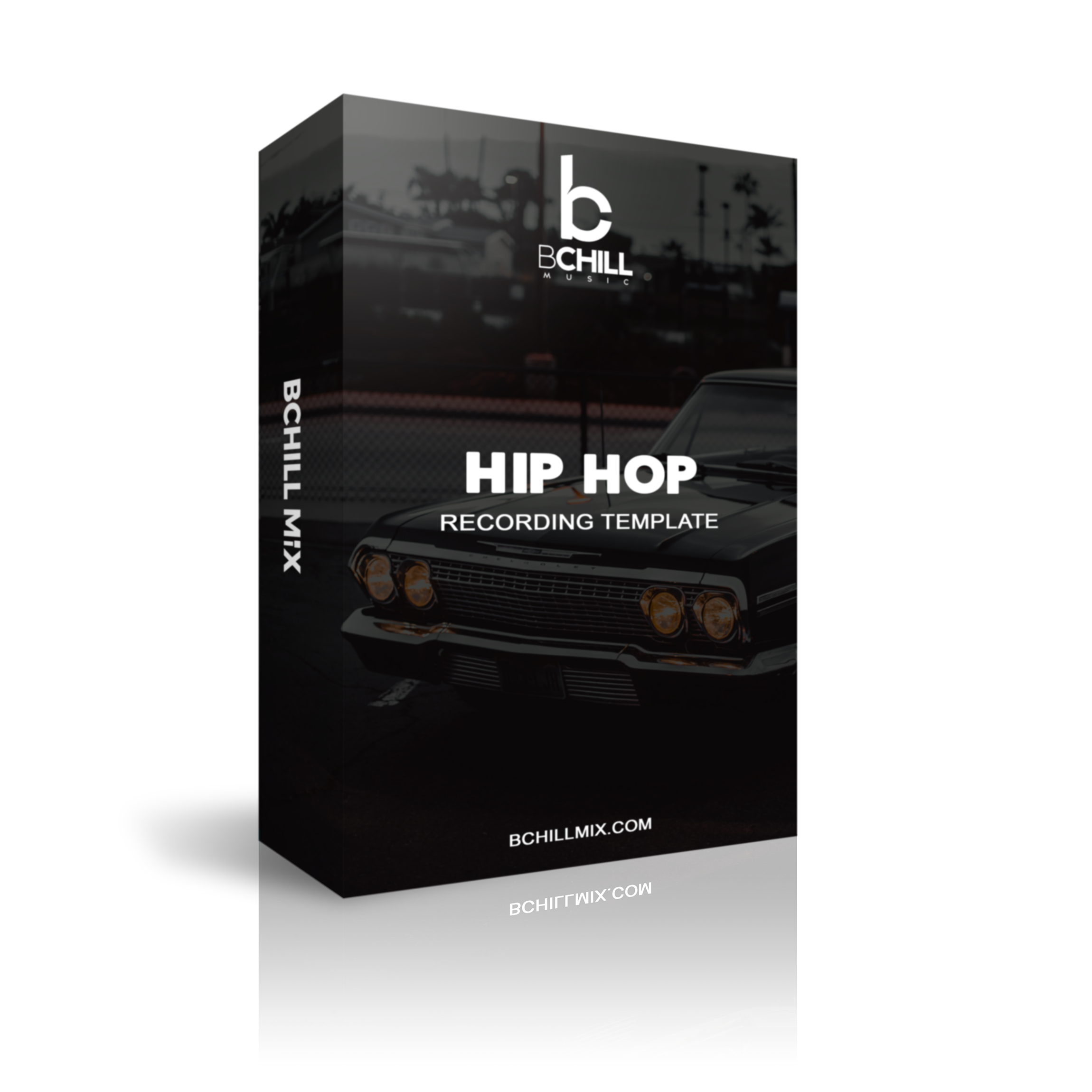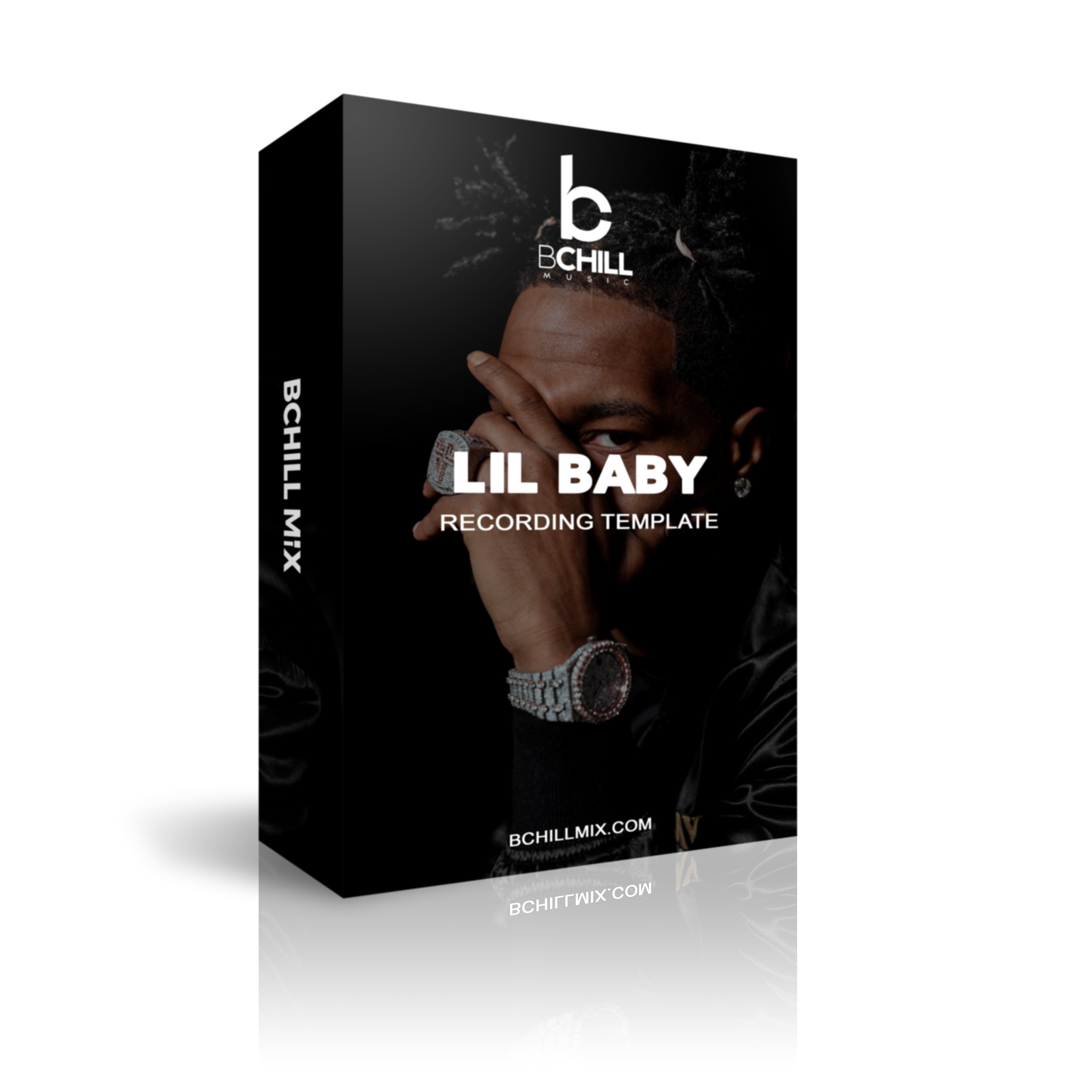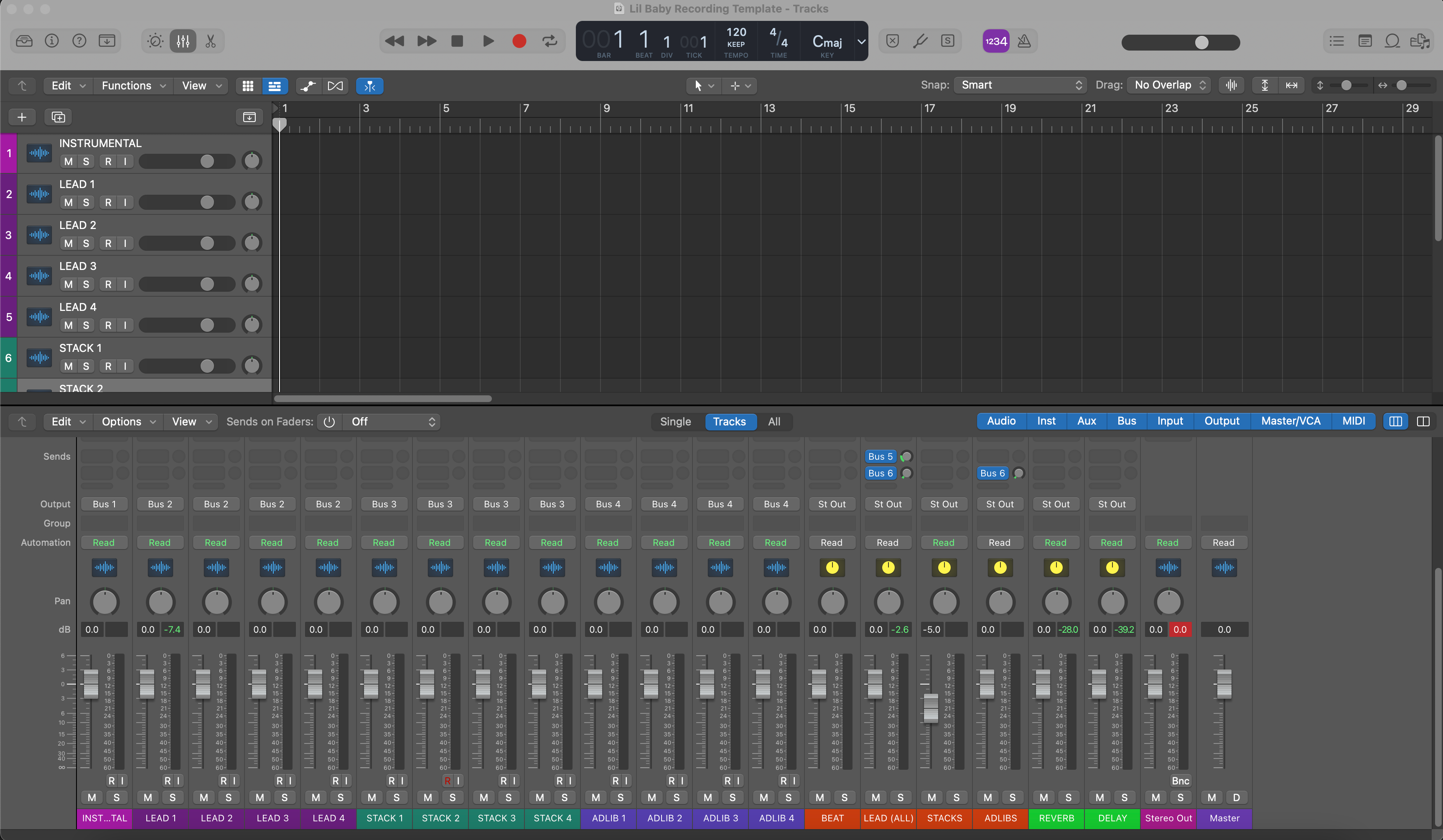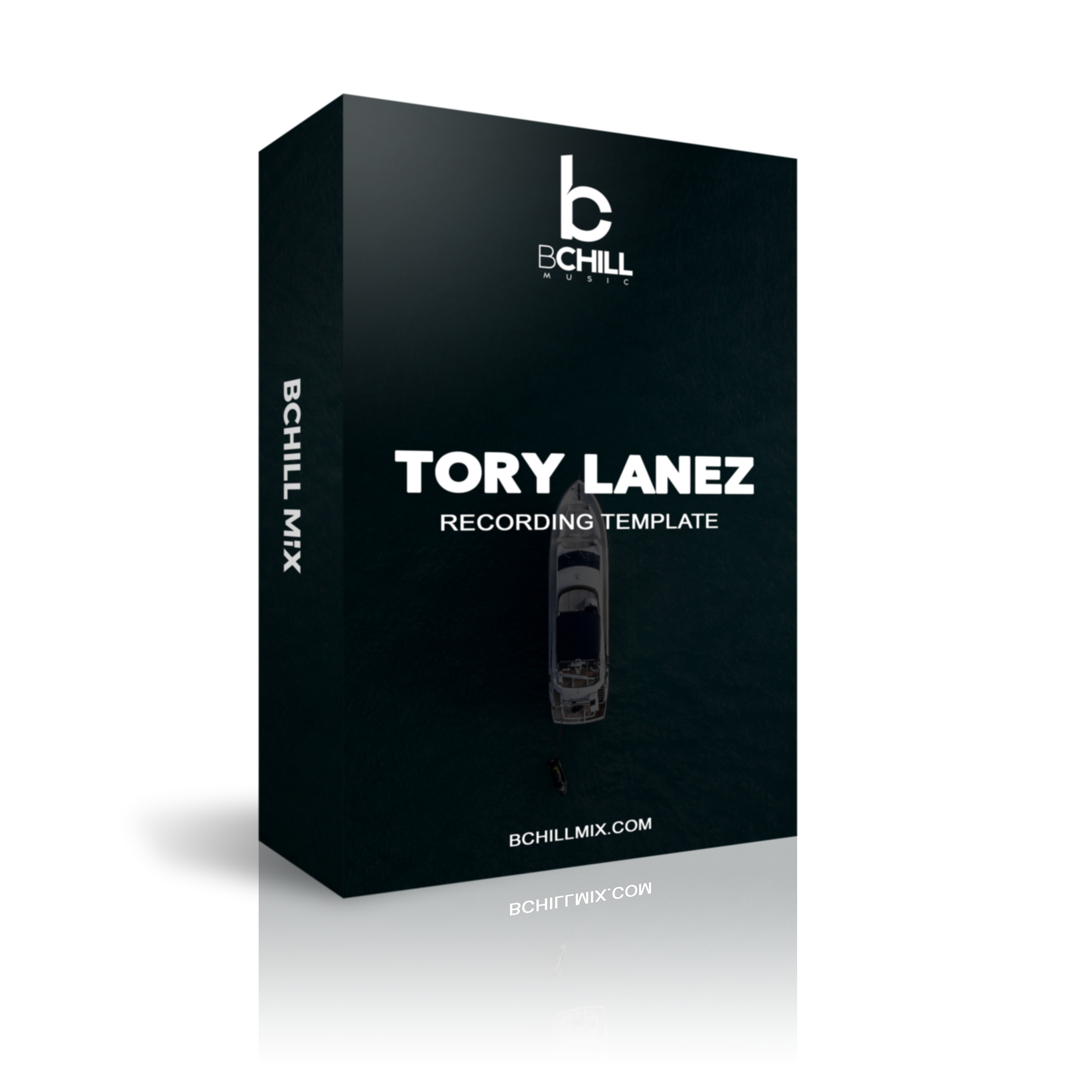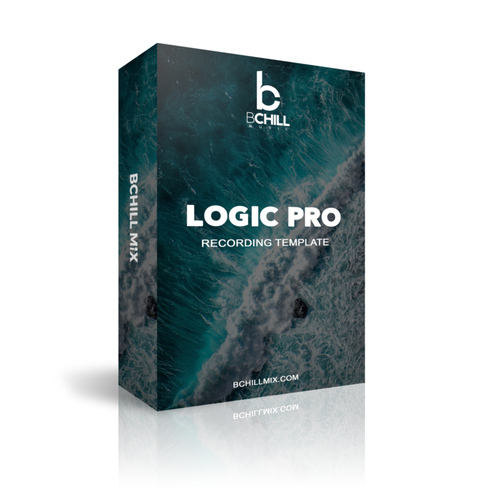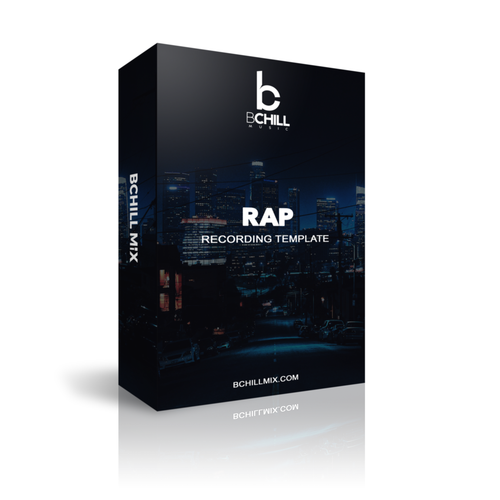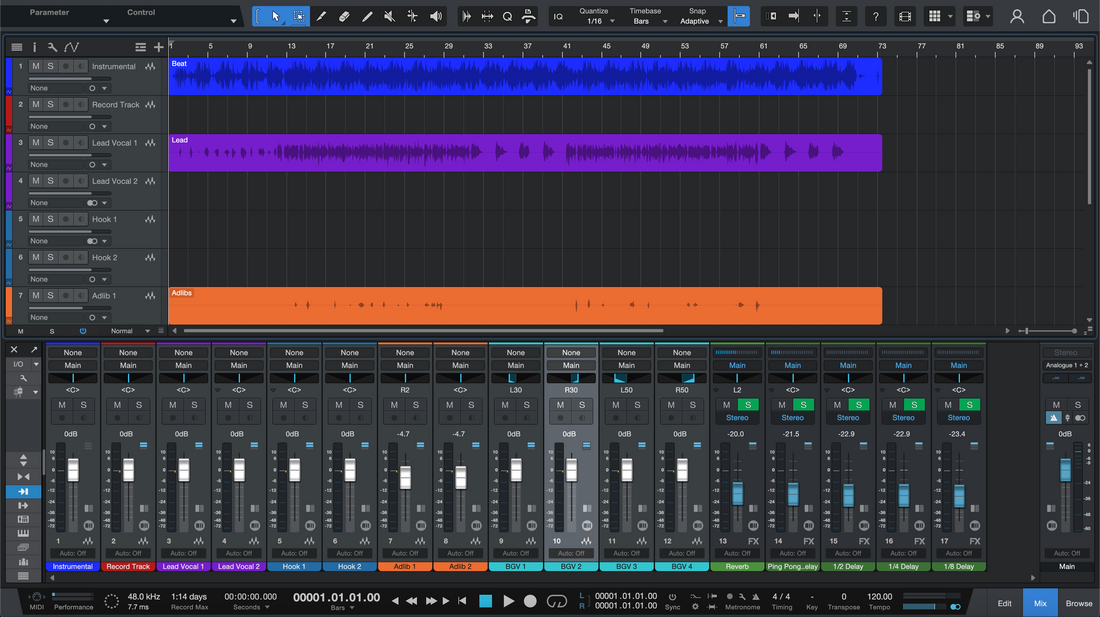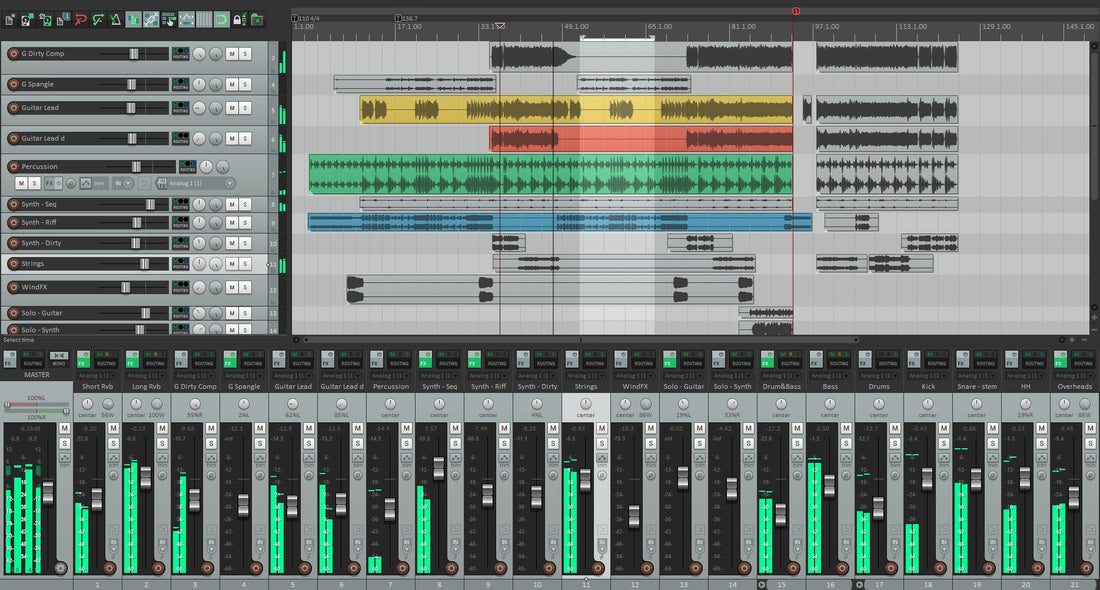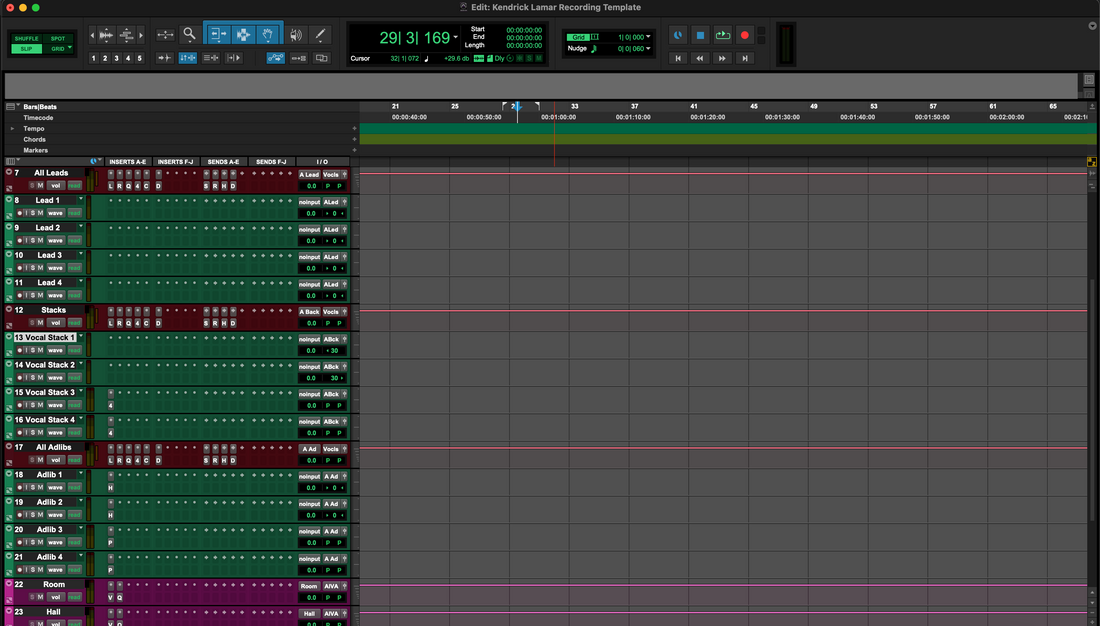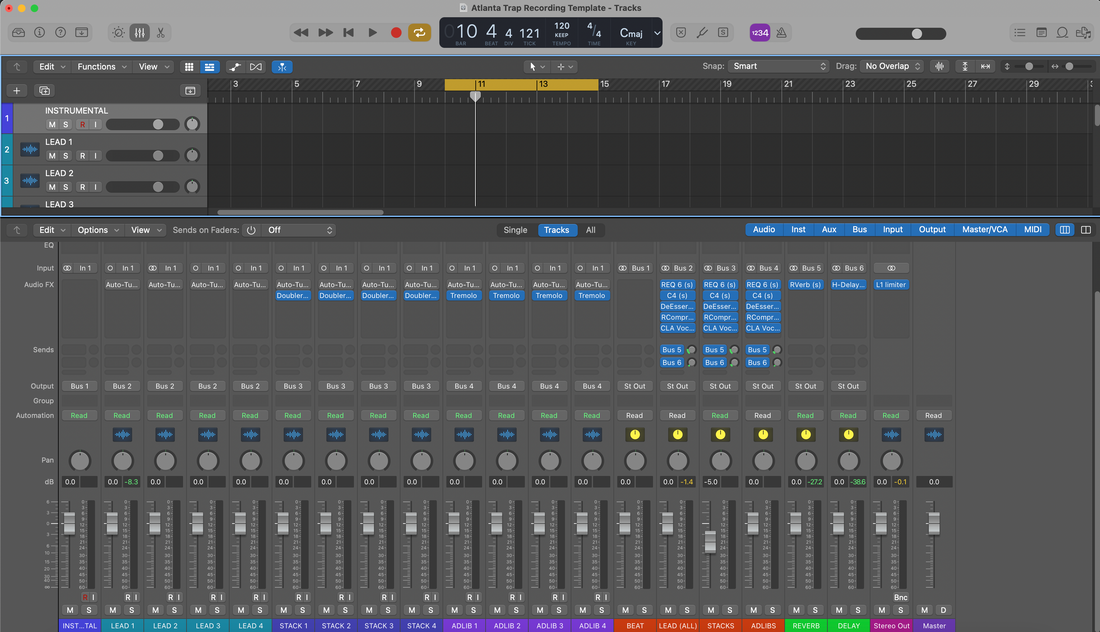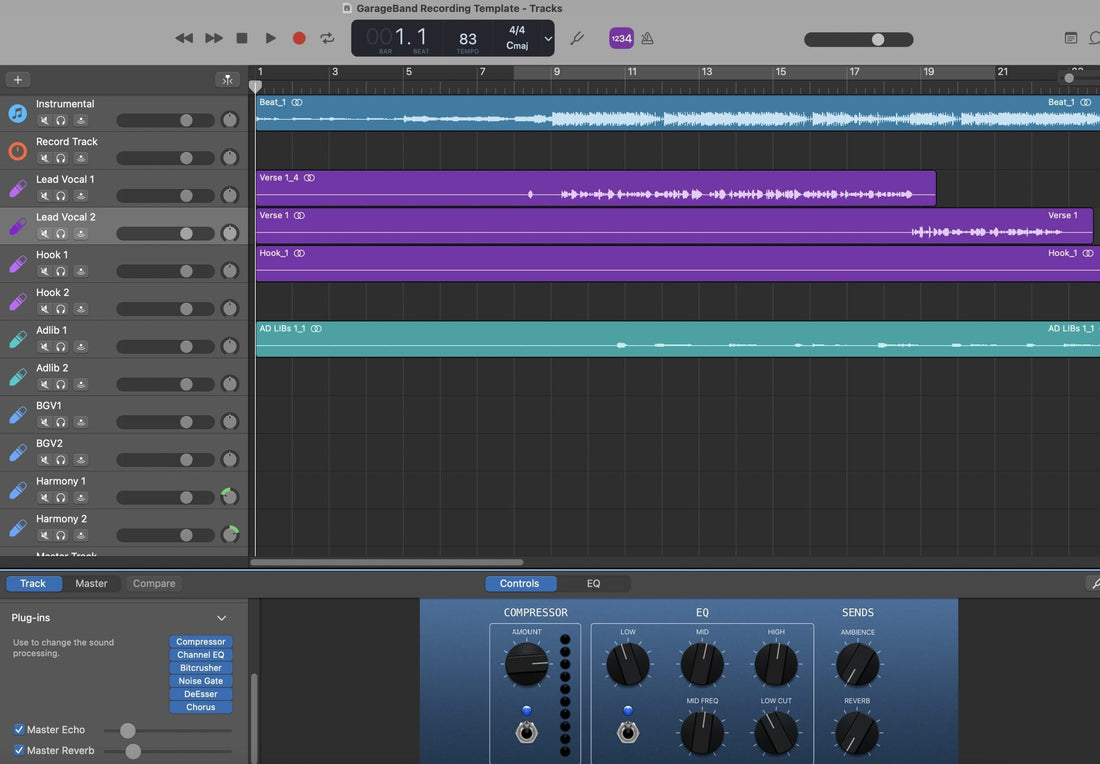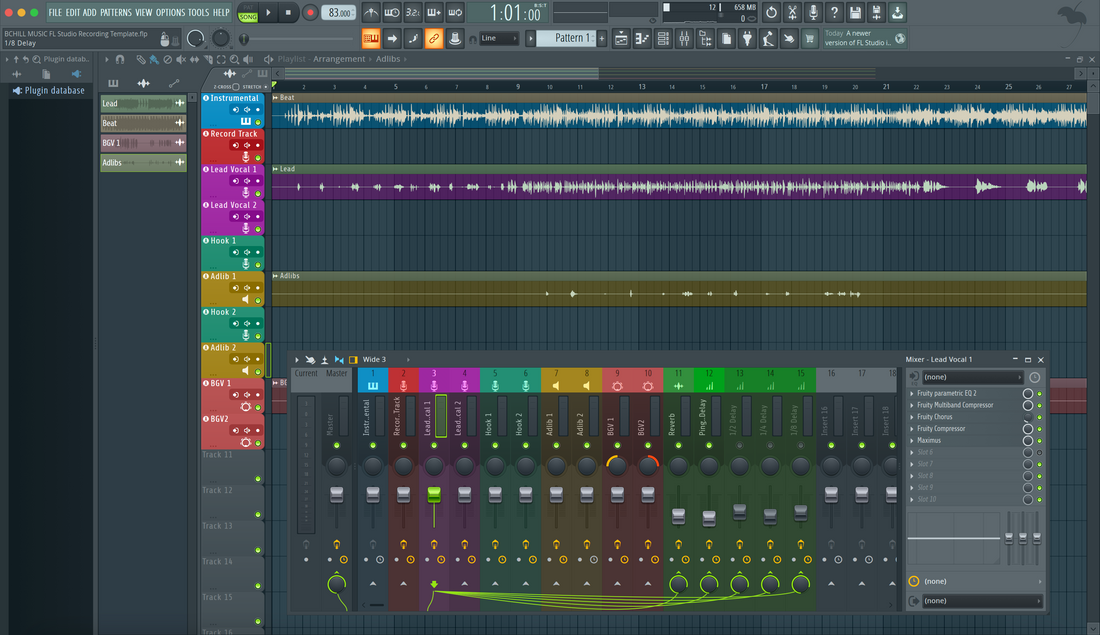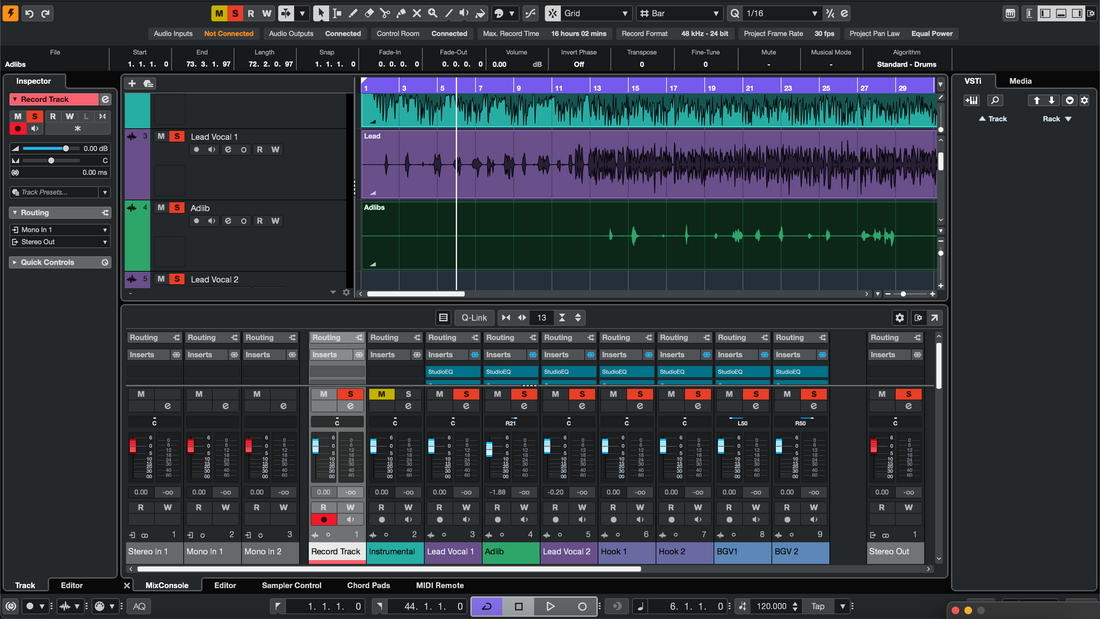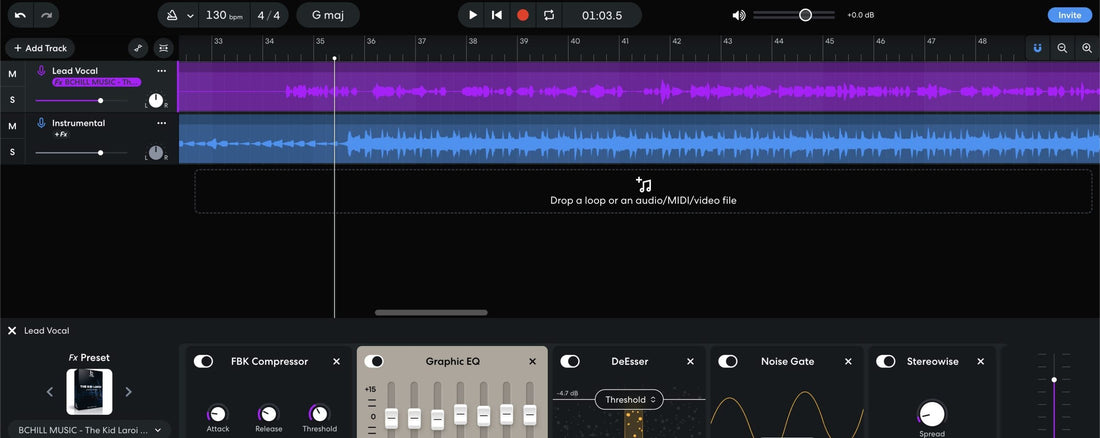Preimpostazioni Logic Pro
Modelli con preset vocali integrati — apri la tua sessione, premi registra e ottieni un suono pronto per il mix istantaneamente.
Tipo: Modello di Registrazione
Modello di registrazione Logic Pro (Plugin standard)
Tipo: Modello di Registrazione
Logic Pro X Modello di Registrazione R&B – Preset Vocale
Tipo: Modello di Registrazione
Juice World Modello di Registrazione Logic Pro X
Tipo: Modello di Registrazione
Logic Pro X Modello di Registrazione Rap - Preset Vocale
Tipo: Modello di Registrazione
Logic Pro X Atlanta Trap Modello di Registrazione – Preset Vocale
Tipo: Modello di Registrazione
Logic Pro X Modello di Registrazione Justin Bieber – Preset Vocale
Tipo: Modello di Registrazione
Logic Pro X Drake Modello di Registrazione – Preset Vocale
Tipo: Modello di Registrazione
Logic Pro X The Weeknd Modello di Registrazione – Preset Vocale
Tipo: Modello di Registrazione
Logic Pro X Gunna Modello di Registrazione – Preset Vocale
Tipo: Modello di Registrazione
Logic Pro X Modello di Registrazione Hip Hop – Preset Vocale
Tipo: Modello di Registrazione
Logic Pro X Lil Baby Modello di Registrazione – Preset Vocale
Tipo: Modello di Registrazione
Modello di registrazione Logic Pro X Tory Lanez – Preset vocale
Crea il tuo cestino
Trasforma la tua sessione in secondi
Configurazione istantanea della sessione con i nostri modelli di registrazione pronti all'uso e preset vocali.




Industria Crediti

Westside Boogie

Shontelle

Jarren Benton

DJ Tunez

Vory

Caskey

Rittz

Nia Riley

Eugy

Q Parker
Informazioni su The Engineer

Informazioni sull'Ingegnere
Ehi! Sono Byron Hill, un produttore musicale professionista e ingegnere del missaggio con oltre 15 anni di esperienza, basato a Atlanta, GA. Ho lavorato con migliaia di clienti in tutto il mondo in una vasta gamma di generi — da artisti indipendenti a talenti di grandi etichette. I miei crediti includono lavori con Westside Boogie, Vory, Shontelle, DJ Tunez, Jarren Benton e Ritz, oltre a creatori e marchi come Daryl Mayes, SeanDoesMagic e Chubbies Clothing.
Nel corso degli anni, ho sviluppato un orecchio allenato per creare catene vocali che offrono un suono pulito, bilanciato e professionale — indipendentemente dal genere o dalla DAW. Ogni preset in questa collezione è costruito con lo stesso obiettivo: aiutarti a muoverti più velocemente, suonare meglio e dare vita alla tua voce con chiarezza, fiducia e intenzione.
Ascolta il nostro lavoro
R&B
Prima di
Dopo
Rap
Prima di
Dopo
Pop
Prima di
Dopo
Anima
Prima di
Dopo
Roccia
Prima di
Dopo
Latino
Prima di
Dopo
Domande frequenti
Questi preset sono adatti ai principianti?
Questi preset sono adatti ai principianti?
Sì — ogni preset è ottimizzato per funzionare istantaneamente. Basta trascinare, rilasciare e iniziare a registrare. Che tu sia appena agli inizi o che registri già regolarmente, questi preset ti aiutano a suonare subito pronto per il mix.
Ho bisogno di plugin di terze parti per usare queste impostazioni predefinite?
Ho bisogno di plugin di terze parti per usare queste impostazioni predefinite?
Offriamo sia versioni di plugin standard (nessun plugin aggiuntivo richiesto) sia versioni premium (che utilizzano strumenti di terze parti standard del settore). La descrizione del prodotto elenca chiaramente eventuali plugin richiesti.
Funzionerà con Logic Pro?
Funzionerà con Logic Pro?
Sì — ogni preset è costruito specificamente per il tuo DAW. Basta selezionare il tuo software dal menu dei preset prima del checkout.
Posso usarli per cantare, fare rap o entrambi?
Posso usarli per cantare, fare rap o entrambi?
Assolutamente — i preset sono creati per stili vocali moderni e includono impostazioni di EQ, compressione, riverbero e delay su misura sia per il canto che per il rap. La catena è abbastanza flessibile da funzionare attraverso i generi.
Quanto velocemente ricevo i miei file dopo l'acquisto?
Quanto velocemente ricevo i miei file dopo l'acquisto?
Immediatamente. Non appena completi il tuo ordine, riceverai un link per il download insieme a una guida all'installazione passo-passo personalizzata per il tuo DAW. Potrai registrare con la tua nuova catena vocale in pochi minuti.
Preset vocali di Logic Pro spiegati e caratteristiche
I. Introduzione ai Preset Vocali di Logic Pro
Se registri o mixi voci in Logic Pro, un preset ben costruito ti offre un tono vocale moderno e ripetibile senza dover ricostruire la stessa catena ogni sessione. Un preset carica un percorso di effetti bilanciato—EQ per modellare il tono, compressione per il controllo del livello, de-essing per smorzare le "s" e un’ambienza di buon gusto—così puoi catturare idee rapidamente e mantenere il suono coerente dalla demo alla release. Da BCHILL MIX, il nostro approccio è semplice: fornire catene vocali che si traducono bene su auricolari, telefoni e monitor da studio, rimanendo abbastanza leggere da registrare comodamente.
Questa guida spiega cos'è un preset vocale di Logic Pro, perché è utile, come installarlo e modificarlo, e ricette pratiche per rap, R&B, pop, rock/alternative, singer-songwriter/podcast e stili orientati al tuning. Vedrai anche come un template di registrazione minimale possa velocizzare la configurazione della sessione e mantenere organizzati i progetti grandi. Esplora le nostre opzioni attuali qui: Logic Pro Templates & Vocal Presets e la più ampia collezione di Vocal Presets.
II. Cos'è un Preset Vocale in Logic Pro?
In Logic Pro, un preset vocale è una strip di canale o patch salvata contenente un ordine noto di processori con impostazioni iniziali sensate. Una catena pulita e moderna di solito include:
- Channel EQ con un filtro passa-alto delicato e piccoli interventi chirurgici per rimuovere rimbombi/domare asprezze.
- Due compressori leggeri in serie (per esempio, una fase “livellante” più lenta e una fase “cattura picchi” più veloce) per stabilizzare la dinamica senza pompare.
- De-esser prima di qualsiasi aria/luminosità così le consonanti restano morbide.
- Saturazione/exciter opzionale per presenza e spigolo (il sottile è meglio durante il tracking).
- FX basati sul tempo tramite sends (plate/room breve e delay sincronizzato al tempo) così lo spazio supporta il testo senza annegarlo.
Puoi caricare la catena su una traccia Lead, duplicarla per Doubles/Harmonies con soglie leggermente diverse, o mettere il processing correttivo sulla traccia e la rifinitura creativa su un Vocal Bus. I preset sono punti di partenza—registra attraverso di essi, poi modifica soglie, quantità di EQ e livelli di invio per la tua voce, microfono e canzone. Quando trovi il punto giusto, salvalo come tuo patch così i progetti futuri si aprono pronti per registrare.
III. Perché Usare i Preset (Benefici e Quando Aiutano)
- Velocità: Apri, scegli un preset, premi record—niente più riscaldamenti di plug-in di 20 minuti.
- Coerenza: Una catena calibrata mantiene il tono allineato tra singoli, EP e serie di contenuti.
- Focus creativo: Dedica tempo alla performance, doppiaggi/ad-libs e arrangiamento—non all'impianto.
- Traduzione: Le catene sono progettate per rimanere intelligibili su telefoni/auricolari così come su monitor.
- Bassa frizione: Meno decisioni al momento—ottimo per laptop e setup mobili.
Dove i preset aiutano di più: sessioni di scrittura veloci, collaborazioni remote, reels/shorts, uscite settimanali di singoli, voiceover/podcast e qualsiasi flusso di lavoro dove vuoi passare dall'idea alla registrazione in pochi minuti.
IV. Stock vs. Premium in Logic Pro (Cosa Ti Serve Davvero)
Catene solo stock usano processori integrati come Channel EQ, Compressor, De-Esser, Noise Gate, ChromaVerb/Space Designer e Tape Delay/Echo. Sono portatili, poco esigenti in CPU e apribili su qualsiasi Mac con Logic—ideali per collaborazioni e setup da viaggio.
Catene premium aggiungono selezionati Audio Units di terze parti (se li possiedi già) per colore o controllo extra—EQ dinamico, compressori caratteristici, saturazione avanzata, riverberi speciali o tuning dedicato. Molti artisti ne usano entrambe: una catena stock per il tracking ovunque e una premium per la rifinitura a casa.
Scelta rapida: sei nuovo ai preset? Inizia con una catena “voci pulite” pulita. Conosci il tuo stile? Carica una catena tarata sullo stile (rap, R&B, pop, rock) e fai piccole modifiche invece di ricostruire da zero.
V. Installazione e Avvio Rapido (Passo dopo Passo)
- Crea e nomina le tracce. Aggiungi tracce audio per Lead, Doubles, Harmonies e Ad-libs. Codificale a colori e, se ti piace il controllo raggruppato, instradale a un semplice Vocal Bus o Summing Stack.
- Imposta ingresso e monitoraggio. Scegli l'ingresso dell'interfaccia sulla traccia Lead. Registra una breve frase di prova e regola il preamplificatore in modo che i picchi restino sotto il clipping. Se il monitoraggio è lento, riduci la dimensione del buffer I/O e attiva la modalità a bassa latenza durante la registrazione; riattiva le catene complete per il mixdown. (Vedi i consigli Apple sulla latenza linkati sotto.)
- Carica la catena preset. Nella channel strip, inserisci Channel EQ → Compressor (delicato) → De-Esser → Compressor (veloce/pulito) → saturazione opzionale → invii a Delay/Riverbero. Mantieni gli inserti per lo più asciutti durante la registrazione; usa gli invii per lo spazio così latenza e dizione restano pulite.
- Regola soglie e invii. Punta a qualche dB di riduzione del guadagno sulle linee più forti senza pompare. Se aggiungi aria, rivedi il de-esser per mantenere la “s” morbida. Usa delay piccoli, sincronizzati al tempo, e un plate corto; automatizza gli invii per i ritornelli.
- Salva la tua configurazione. Conserva la catena come patch utente o impostazione della channel strip. Salva un template di progetto così ogni sessione si apre con routing, headroom e colori coerenti.
Note sul gain-staging: registra con un headroom sano (picchi intorno a −10 a −6 dBFS sul misuratore della traccia); evita luci rosse sull'interfaccia—il clipping non si può correggere. Se il makeup gain alza troppo i livelli, riduci l'output del clip o dell'effetto invece di spingere troppo il processore successivo. Mantieni i picchi del rough mix sensati per non inseguire la loudness durante la registrazione.
Opzioni di tuning: per correzioni delicate, prova il plug-in Pitch Correction all'inizio della catena (prima del de-esser). Per modifiche chirurgiche, usa Flex Pitch sulle take dopo la registrazione. Ricontrolla la sibilanza se poi schiarisci la voce.
Riferimenti utili (dopo aver incollato questo articolo): le guide Apple sulla gestione della latenza di ingresso, Channel EQ e Flex Pitch.
VI. Ricette di stile e soluzioni rapide (Rap, R&B, Pop, Rock/Alt, Cantautore/Podcast, Tuning-Forward)
Rap Lead (pugno moderno) — Due compressori leggeri in serie mantengono la dinamica stretta senza uccidere i transienti. Concentrati sull'intelligibilità intorno a 2–5 kHz; taglia piccole zone nell'instrumentale invece di sovra-potenziare la voce. Aggiungi uno slap corto o un piccolo plate per energia senza wash. Solleva i ritornelli automatizzando l'invio del delay invece di alzare troppo il livello wet dell'inserto.
Melodic Rap / Trap — Punta a un top brillante ma morbido. Un tocco di saturazione prima del de-esser aggiunge mordente; seguilo con il de-esser per evitare che le consonanti risultino sibilanti. Per gli ad-lib, alza leggermente il passa-alto e aumenta un po' il de-esser per mantenere pulite le pile. Allarga i ritornelli con un po' più di feedback del delay e pre-delay sul plate.
R&B / Soul — Attacco/rilascio delicato, equalizzazione soft air, ambiente più ampio. Se i boost aggiungono fruscii, riduci la brillantezza o aggiungi un secondo de-esser più morbido. Usa filtri passa-alto per gli sfondi e ritardi stereo lenti che stiano dietro la voce principale in modo che il testo resti in primo piano. Per pile ricche, sperimenta con un pre-delay più lungo e un livello di invio più basso così la coda del riverbero non copre le parole.
Pop — Alti lucidi con de-ess accurato, delay sincronizzati al tempo per spazio ritmico e un riverbero room molto breve per “colla”. Prendi decisioni a volume corrispondente così il “più forte” non influenza i tuoi controlli A/B. In arrangiamenti densi, taglia 2–4 kHz in chitarre/synth per mantenere le parole intelligibili.
Rock / Alternative — Mantieni la voce in primo piano senza durezza: compressione moderata con un piccolissimo tocco di saturazione, poi de-ess. Per energia, usa riverbero breve room/plate e uno slap mono intorno a 80–120 ms. Se i piatti competono con la brillantezza vocale, taglia un po' di high-shelf sul bus batteria invece di esagerare con il de-essing sulla voce.
Singer-Songwriter / Podcast (voce chiara) — Dai priorità all'intelligibilità e al controllo del rumore: compressione trasparente, de-ess moderato e un accenno di ambiente breve se il dry sembra innaturale. La tecnica vince—distanza costante dal microfono, filtro anti-pop e una stanza silenziosa batteranno sempre effetti pesanti. Se respiro/rumore è un problema, automatizza il clip gain intorno ai respiri invece di usare gating duro.
Orientato al tuning (hook & pop iper-pulito) — Imposta prima la tonalità/scala della canzone. Usa quantità moderate di retune per un feeling naturale o spingi più forte deliberatamente per un tono robotico. Dopo aver schiarito, ricontrolla il de-ess e regola le soglie affinché la sibilanza rimanga morbida.
Rimedi comuni:
- Sibilanti “s/t” dure: riduci leggermente lo shelf delle alte frequenze e/o alza la soglia del de-esser in modo che agisca solo sulle sibilanti.
- Bassi medi rimbombanti: tagli piccoli e stretti intorno a 150–350 Hz; high-pass per doubles/armonies più alto rispetto al lead.
- Voce sepolta nel beat: crea piccole tasche negli strumenti concorrenti (2–5 kHz) o alza il vocal bus di ~1 dB nei cori.
- Troppo spazio: inizia con send bassi; automatizza nei ritornelli invece di mantenere riverbero/delay alti per tutto il tempo.
- Latencia durante la registrazione: abbassa il buffer e abilita la Modalità a Bassa Latenza; registra con una catena leggera, aggiungi gli enhancer dopo.
VII. Preset vs. Template di Registrazione (Workflow Scalabile)
I preset vocali modellano tono e dinamica su una traccia o bus. I template di registrazione ti offrono l'intera disposizione della sessione—tracce pre-nominate (Lead, Doubles, Harmonies, Ad-libs), codifica colore, instradamento bus, basi per il cue mix e send pronti—così puoi passare dall'idea alla take in pochi secondi e mantenere ordinate le sessioni grandi.
- Apri il tuo template per garantire che headroom, meter e routing siano coerenti da canzone a canzone.
- Carica la catena di preset che corrisponde allo stile (Rap, R&B, Pop, Rock), poi salva la tua versione modificata come punto di partenza per la tua “voce”.
- Usa uno Summing Stack o un Vocal Bus dedicato per la lucidatura creativa (exciter, compressione leggera glue, modulazione), mantenendo le correzioni sulle tracce.
Se collabori, condividi un template compatto e una o due patch di riferimento in modo che tutti sentano bilanci simili anche su computer diversi. Quando vuoi un punto di partenza organizzato fin dal primo giorno, esplora le opzioni attuali qui: Logic Pro Templates & Vocal Presets.
Ultimo aggiornamento: agosto 2025 · Autore: Byron Hill (BCHILL MIX)
All'interno della DAW: Impostazioni del preset vocale di Logic Pro (Screenshot)
Guarda come la nostra catena vocale di Logic Pro si carica su Lead, Doubles e un Vocal Bus. Questi screenshot mostrano le impostazioni iniziali per rap, R&B, pop e rock—modifica le soglie e gli invii per adattarli al tuo microfono e alla stanza.



